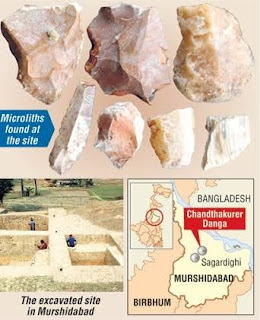Chandthakurer Danga, Remnant of a 20000 year old Human Civilization
Humans walked on Bengal’s soil 20,000 years ago, archaeologists have found out, pushing the state’s pre-history back by some 8,000 years.
An excavation in Murshidabad has dug out stone tools — knives and needle-like “microliths” of agate, chert, chalcedony and quartz used by these hunter-gatherers — geo-archaeologists S.N. Rajguru and B.C. Deodare of Deccan College, Pune, confirmed to The Telegraph.
The two experts have examined the site at Chandthakurer Danga in Haatpara mouza, 8km northeast of Sagardighi, excavated by the Bengal directorate of archaeology.
“We had been expecting finds from the sultanate period (15th-16th century) and perhaps early medieval black and red ware, but nothing like this,” said Gautam Sengupta, state archaeology director.
“Some 200 tools have been found so far, proving there was human habitation in the region long before what was earlier estimated.”
A few such implements had earlier been found in Birbhanpur, Durgapur, in 1953 but they were only 12,000 years old.
Modern man, Homo sapiens, is believed to have arrived in India in waves between 70,000 and 50,000 years ago, with the oldest tool sites found in the country dating back over 30,000 years.
“We discovered the (Murshidabad) site by accident,” Amal Roy, the state archaeology department superintendent who led the excavation, said over the phone from Murshidabad.
“An excavation at nearby Geetgram was aborted because of local resistance and we stumbled on this mound (Chandthakurer Danga) towards the end of January. We wrote to Delhi and obtained the licence to dig. The excavations began on February 10.”
The upper layers of the 144sqm site threw up fine-quality ceramics from the sultanate period as well as decorated bricks, medieval-era terracotta and bangles, Roy said.
“But at a depth of 2-3 metres, we found a deposit of yellow, older alluvium with calcarius and manganese nodules typical of the Pleistocene age (from about 1.8 million years ago till 9,550 BC),” Roy said.
“In the top 70cm lay the tools that Rajguru and Deodare have identified as belonging to 20,000 years before the present era.”
The tools include tiny blades 1-4cm long, points, lunets (sickle-like blades), awls (to make holes) and scrapers.
“We also found the raw material from which the tools were made. Stone flakes and debitage (residue or waste material) form 60 per cent of the findings and the tools only 40 per cent. Therefore, Rajguru believes, this must have been the site of a tool-making workshop,” Roy said.
The excavations will be suspended soon for the rains. “We hope to discover at least 50-60 pieces more by then,” Roy said.
He added that the local population had been extremely co-operative and the department hoped to resume the excavations next year.
Text collected from Telegraph India, March 2008.
Source:
https://www.telegraphindia.com/india/history-of-bengal-just-got-a-lot-older/cid/603572




Comments
Post a Comment